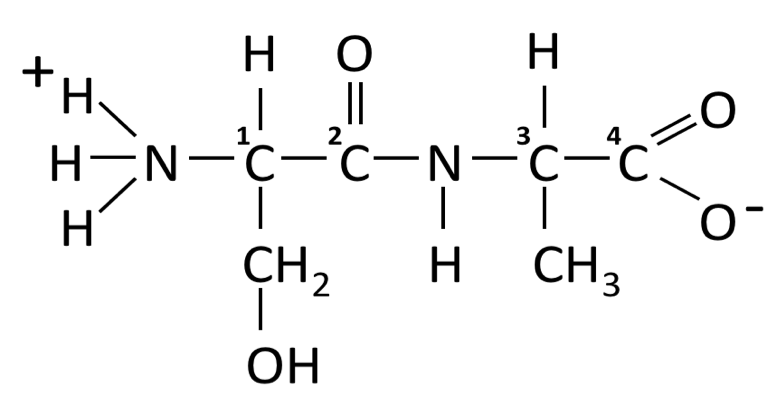Chapter 1. Question Suite 4.1
Introduction

Question Suite 4

Author: Mark Hens & Melissa Michael
Synopsis
Core Concepts:
4.1 Proteins are linear polymers of amino acids that form three-dimensional structures with specific functions.
4.2 Translation is the process in which the sequence of bases in messenger RNA is used to specify the order of successive amino acids in a newly synthesized protein.
4.3 Proteins evolve by combining functional units and through mutation and selection.
Learning Objectives:
- Draw one of the twenty amino acids and label the amino group, the carboxyl group, the side chain (R group), and the asymmetric carbon.
- Name the four major groups of amino acids based on the properties of their side chains.
- Describe the importance of peptide bonds, hydrogen bonds, ionic bonds, disulfide bridges, and noncovalent interactions to proteins.
- Explain why the order of amino acids determines how a protein folds.
- Explain the relationship between protein folding and protein function.
- Describe the relationship between codons of mRNA, anticodons of tRNA, and amino acids, which, in turn, determines its function.
- Describe the process by which ribosomes synthesize polypeptides.
- (CHECK ON THIS ONE. NOW IN CHAPTER 5?) Explain why protein sorting is important to the cell, and three ways in which it is accomplished.
- Name and describe two ways that proteins can acquire new functions in the course of evolution.
Click the Next button to start this activity
1.1 Proteins

Question 1.1
Isd7TultpJnU0Br8IWLWRuHYbryHLoa2J3mNpE7sUfg3Y0H8yhZ/D4Ask+o1NDgIS0R98C1+gBr+wopKPkm4NHDa4Mu0hjgo87MmR1BEOP8rjiYNGJkfNsz6u0ky52yTOzmKcniVf9N93Iu8S9RwEyXM9CsVnO/w3cKqo4HT6G423Iq9fICjnfsxksr1dw1Qwk507aq6GKsRvQeipkXRaCsza33qFCFZqgIr28DDDAr+WadGuUCdxw4g7wjLn6L0H7mwHa5p/wYm3vM0LXD4KfJnxy/il45QzBwioQ==Question 1.2
oKa3ykItyanypAczAECl2VC1IOxXRMBXhR73d7WgG4bPSmfaS1Hjd51TcfKwo59HUICx6bh1DXcjAXPaj5051oxSscbUHGLp+ralMvbfvRhl2n2HH4KKzgLcUGZ44fF733UcUvE65dY9nX4wJIQJShygLwJDzGkDO3+JDes87EwoVZuS+BfW1LLsP9eDs5vZcU3dL2HrXPeJeu3WoQkjjQTnt0ZVgArkhsgHsDMFgpTrJe/Nj/G5fCKh54TuZIBe1RClgXIxBEZY68rYrP/vbOxenyiLrWRE3+XXxS5Rl02D6JKoD/S4qi4QhE2npOL+6psRmywz8GGW6z7b/zOgVxqTQWY=Question 1.3
Yq/Us8nNRFCdIHlzlo3gP1hqUFCM6P18E8BWLgrybBa7zPyLIbHJT5TB6U2kvl+LCjS1IyuB9ZbUHMty7CeD2HMzpXMpLad9sfofnb/Anp7waboqhW9C9WoLhoimUtLuz0LDI9vkwmdZ7WNSFk2aw/chWJeyVCIW7SEwDM+AyJ7k2Q54+cDOzi0YkDHPBxfF3r9lm1JZpPdFyqw6uMlc5Reb5S52YK8V2ibgupzVx41E4Xyz/39ESnt2oKkdeKJ+2jOTRqrv3cJkv2ImAkpgEIzkkVrDFjoT5d5nQw==Question 1.4
k6Mb6T03GMmqe3wfs/3Xs4h48tjOKiKAZp6NVGg23JvZwClNUrDPrBkK1bBM+kImyHKlAAV7zcohSfKRjvzdScFC9G8yizqUsVpW8r3hinP/jKbjcL3IQPoFa9b38KVsLXpQemmDwgAc5FqT9Ea6WLmvt+xg38xgXDgP7ZRXJnUP+cMgkYzqUP5eqqzAvUPY8cxgxjikfTKmFOyE1mGzVGqeXLyq4gbDTkIuDuzC2ltaTRBPpUxqQJbl7oQF156igq4Jg6Uh2JBi2YQZzTxMJR0M6wvlCqbM92F5Mi1UzcY=Question 1.5
iDzIaZhmLuefnRG0bMs9sePe2Fnl5NHAgAN1Huu0h4qtCu6jHomVetbtvn84DMoKGbBdqiSgUNsfOgiIKe2m0R3DTrGceXVbonj3dx3IcZhtef4KK+KZcfpsAbDJnkFMhIpHcF4X/hLiLaV15HBgeODiInZ41LPJuQIscYBVGelSXhldgV9E8RNP2j3HKptu+QJ6xaj6s6/KqjGywDcEJeP+oJwtCb2Pp5EDY0Ld2wW9q4jvPEtbFbKHjiXInuk/dZn5uKgs2Xjxo5G1rtfwW14I7flLs0l36yXNhP8xowUqUodQN/u1SZ2RZSLEqFTVVuZEJEeerKnKl4Qt0NMfOLAhVTRlptR4v4E9YFuZNGA4EsDpDXCfkmBfGQb7gkTW+z4Z9bm61nrlXVA+TXuYcY88LGZzF/i+1.2 Water
Question 1.6
How many water molecules would be produced in making a polypeptide that is fourteen amino acids long? JcJPCnQl9JEHaVPK
1.3 Check Your Understanding
Question
fXFq1Ui1/19IUgdORBc+UpDf7ub6ny/qvU7X8za2tJPHJt+VpNwwuku4Hhek4s471LcFo7rR5lrwVEaoD686ZiW6T4T5YRgJFr8v2oljeiojBklQ2nRl7to6LjNOPsS8wFTTNOHEVrSmvnmOF39H3SE5POkK0H4ZC0yKO0r31KatTfzaVMCRs5o3etjdMwOAddCj+QIuvvxyFv48W0Z5DU1RWx2Bl5hnrvB153C6KJuP2qzNogEPZgFPUN7NzFoBGr8kRNxgi7VVSkyGoU3TnY+8wYTzf3OIXvU0sMMI5y5u91WoZykVd1M6M5fttaBYTVnilQsEMU8LGNsyxW5LksOciX6lUY51WryVmZ+Wc49xaB6Mpp40APu6Y+Dqr4zLxeYwn13ZkoWlNg4N1FdLkuiADYgDnvaEKwdJH7iIo8leC3pAixh+N/3kzw1G7fXv7Uh9EB2xDsQ/YhTnvymcqoAi1/dkUigHF5lYKrAl7KyNReDODY3axvHQB6qWdQ5YmgtnBwF3THdnZbHc4mbbjmU9PJKR4d2EqHU5POsGIhjUsiENfCVs3I2ca9Cm3F7tY96/s1jdJf8P4GjWN8LtyoJnFK0Jv52vkoM4d/H/elE6USEzMT6LE5EzlEOf29LGMAhMfxqYI1lPAGcVkZl26PRrpUA=Question
Tr7a7xoUrv7X9jJwAtJJhRxhGGuD6r2kXiIt5YDCMVka1PMW0fXWXxo2+koBDnAKoKMDxTKuuYImMtj0ad2jEpVup+cTytoZn1+BvhxY3Vk1k54KJR70cZre55jVoFoftxYRT7ST2BLEW0D1hqcOC2ZOiDrRCUsaVIOan3CagASzZRrTPFA8MT2aJ4y23D/rFX8LB+OKWIUD8sYVokNVrcZjlbJtZ3x72txb1pirvC6iDGGwFSQC0VEtRPBsE8hlGm8nB72sEAlxJJFvnMhUX7mdLDxj2pLoQ0Si4yqPJrnUXsdA39p5E5iTZJg7HPCz7ByOu0LZIRLSLcOwERBwc88Ar7eSVDRyjE/2XTJP8wLIqnYjYuktgOTpmIcYzln8Uw+sEnQurzFnxoddm3EnBuFPiPGulifbLxCf+uhXJdTYLBL91hbbyTBKEngPtfCWzwmGwLknpfKUnEndVoyJgOotogLUWYyEJ2OCwR+nhOMqPNIqhSRdoPGiHLka29HQWUM4KO39S9S2i4KIJcEXL+6JpTNKzcTFSxEdaG0s/AMv5YueqrWDD0vGg7WP730E5Q92V9flaULg+YLPtPxiqGS59VZq8eKg2ID3ucx06bZsJXs4YRvRY05rbDddC3bSDA07cUoX73uIsVcYWoKE+nfsSIje7QG6fYvIxsc8LmuH7FhUBoXt3CA9oayLvno2K+Tkdj1ETvETy2E6cTgCB0La4D3TW1+VOLZUpsREhkJDvr0Y32QCYC43FhwD3ycNqBR7ooXeWyxxDBN9TxjwcmmiyWSBlenKHDB7+NiZ0F5DE7GpgAcqGODIzq+80QQ9r5c03mF/CvrGF5vXS7qbDvZPJaWVClX+72IFJyACW7PtmsgfACYydlST6/sHya9FehJr0/d3LL5xs+zEOeqq6D/Lv5g=Question
JHfFRQfuGa+PBndOndShIToB1OLxalzlUJft/wBN3Ee18wq7WL0mtRL0lSe8FEsUAW5lRaT5cfzxJDZ7xjBckq5xcWOQkCrYv1xAqoQh4xX7LHMPzqjNYwwarF0AyaiNlplu8cIcVPr0VpWQZrZjfzuPnTy+nvGbFXuZ/CUnA3H5PA9i22hBHdxPlzP+Kzz0rN0fIfase/fbadBmxzt7V+IYzKyrP9q0PuQC075u+7IyJ3Izr0i/EaQSgaGMNgZ+VJu/2GPBCpOQo135Lt2l33L0kOF8Ee6pG01RKL6eUY3+FHOAfwzjcvWCW/Ht7cXqxn87T4OWGx3Sykb2BPjw0DYQKLnVFJC/vsJlBjM/GasyhHTo7ewVYMzfkvhFfphk2Q3NGOf4z1pfNBShKcs3lzz7Bicx8iYnXEPnkGOjeo1xOgzO3yibQTzYw83m6JAkRZqkXtCQ/ZqiF3lNTtVCQzq7UmXfePmXXzP0ACC4B+mR/sd5ZFrC2fKDkbY63DXAc+wESCHw5UiA52/cpBDDXd23mpDvBJ3QTbBkxA==Question
ulLBwX9bwqXfmL16wR7irf6oxTeJuSAkYF8UhX6UGSYzFc2iNHyaLJ99CPXNKf1KR3G8+aAg4H0QXOT/5SYs19sF4JDPRChio9mdKrIe4fTTCoWwkG07n3noO085/q1e2mIh5YDU79vnTOtnmfv877lgVpF4NP0DSN9OSCOxShainRbB3iz6LUBCnIILWutafGaU6g38okhSGXJp1.4 Activity Completed!
Activity results are being submitted...
REFERENCES:
[Center for Disease Control] CDC Grand Rounds: Childhood Obesity in the United States. URL: http://www.cdc.gov/mmwr/preview/mmwrhtml/mm6002a2.htm?s_cid=mm6002a2_w Retrieved 3/31/11
Collins, A. & Peebles, R. (2011). Pediatric obesity: A pediatrician’s viewpoint. In Debasis Bagchi (Editor) Global Perspectives on Childhood Obesity: Current Status, Consequences and Prevention. Pages 257-264.